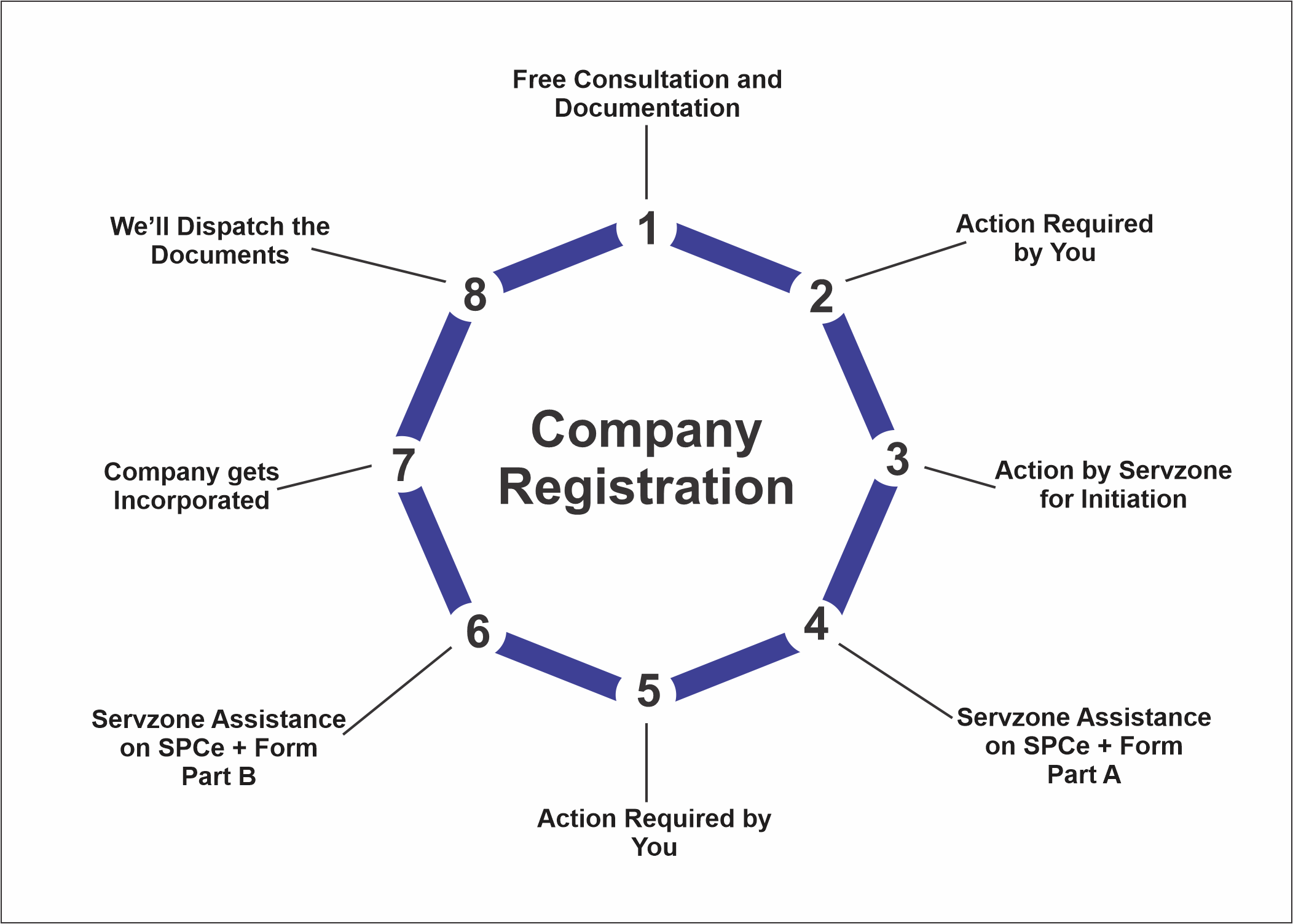Get Started With
servzone
Overview
Public limited companies enjoy all the rights of a corporate entity with limited liabilities and are an ideal option for small and medium scale enterprises who want to raise equity capital from the general public.
Below we are going to provide complete knowledge of facilities, process and document requirement for public company registration.

What is a public limited company?
Like other companies, a public limited company is also registered as per the rules and regulations of the Companies Act, 2013. A public company gets the benefit of limited liabilities for its members and has rights to sell its shares to increase the capital of the company. It can be incorporated with a minimum number of three directors and has more stringent rules and laws than a private one. Limited company.
There should be a minimum number of seven members while there is no limit to the maximum number of members. It offers all the advantages of a private limited company, along with greater transparency and easy transferability of ownership and shareholding. Name, share, formation, number of members, management and directors, etc. distinguish a public company from private limited companies.
Required Documents
An applicant must collect all these documents to file with the incorporation application:
- Identity proof such as Aadhaar card, PAN card, driving license, voter ID of all the nominated directors and shareholders.
- Proof of address of all proposed directors and shareholders of the company.
- PAN card details of all directors and shareholders
- Commercial location of utility bills such as telephone, gas, water or electricity bills as business proof of registered office. It should not be older than 2 months.
- A No Objection Certificate or No Objection Certificate from the landlord of the place of business.
- DIN or Director Identification Number of all nominated directors
- DSC or Digital Signature Certificate of the designated directors
- Memorandum of Association (MOA) and Association of Associations (AOA)
Features
Important features:
- Number of directors in the company
As stated in the provisions of the Companies Act, a public company should have a minimum of 3 directors to include a company, while there is no restriction on a maximum of directors.
- Name of the Company
All the Public limited companies must add “Limited” word at the end of their name. it is denoted as an identity of a public company.
- Prospectus of the Company
The company's prospectus is mandatory for public limited companies. It is issued by the proposed company to its general public.It is a note of comprehensive statements of works and affairs of the company. However private companies have no such compliances as they don’t have rights to invite the public for their shares.
- Paid-up Capital
As per the requirements of the act, no minimum capital required for the registration.
Difference between a public limited company and a private limited company.
Different points:
| Point of difference | Public Limited Company | Private Limited Company |
| Members | Minimum: 7 Maximum: No Limit |
Minimum: 2 Maximum: 200 |
| Directors | Minimum: 3 | Minimum: 2 |
| Public invitations |
Yes |
No |
| Minimum Capital Income | No | No |
| Issuance of Prospectus | Required | Not Required |
| Name differences | Must have “Limited” at the end of its name | Must have PVT LTD at the end of its name |
| Mandatory Statutory Meeting | Yes | No |
| Managerial Remunerations | There are no as such restrictions | Cannot exceed the limit of 11/% of the net profit |
| Stock Exchange | Is listed on stock exchange and stock trade is carried out publicly. | Not listed on stock exchange neither carry out stock trade publicly. |
Benefits
- Limited liabilities of the shareholders
The shareholders of a public company take advantage of the limited liabilities under which their assets are secured and cannot be used to clear the debts and losses of the company. Despite this, shareholders are responsible for their own legal offenses. All members, directors and shareholders enjoy this right and their property cannot be confiscated by any bank, creditors or government bodies.
- Perpetual Succession
A public limited company is treated as a corporate body with successive succession. In case of death, retirement, insanity and bankruptcy of one or more members / shareholders / directors, the company still continues its existence. <.p>
- Improved capital
In a public limited company, the general public is invited to buy shares of the company. Therefore, one can invest in a public company which improves the capital of the proposed company.
- Borrowing Capacity
A public company can enjoy unlimited sources for taking loans. It can issue equity, debentures and sell its shares and accept deposits from the general public. In addition, most financial institutions find public companies more prominent than other unregistered companies.
- Fewer risks
Since public companies can sell their shares to the public, it lesser the scope of unsystematic risks of the market.
Better opportunities for growth and expansion of the company: -
Low risk creates better opportunities so that the company can grow and expand by investing in new projects raised by selling its sales in the market.
Registration Procedure

- Step 1: Apply for the Digital Signature Certificate
First of all, you have to apply for a digital signature certificate for all the proposed directors in the company. DSC is used to sign e-forms and is an authentic and secure way to enter all documents on an electronic platform. It is a mandatory document.
A director can easily obtain DSC from the nearest Certifying Authorities or CAs with self-attested coppices of their identity proof. It takes around 1 -3 working days to obtain a DSC.
- Step 2: Apply for DIN
The Ministry of Corporate Affairs has simplified the DIN process, as an applicant can apply for it through SPICe + form and there is no need to fill any other form. It is mandatory for all the directors of the company to apply for their Director’s Identification Number.
- Step 3: Name Verification
The third step involves name registration of the company. You can check the name availability through the MCA portal by following this step
Visit the MCA Portal> select the MCA services> Click Check Company Name
Note: The company name should not be taken or registered and should not be similar to a brand name. - Step 4: Filing Form SPICe+
Once the company’s The name has been approved. Now you can file SPICe + form to get a company incorporation certificate. With this, you have to file all the necessary documents such as MOA (Association of Memorandum) and AOA (Association of Associations). These two documents detail the mission, purpose, objective, vision, business activities, responsibilities of all directors and shareholders, and the definition of the proposed company.
All the documents and applications are further verified by the higher authorities and it takes around 7 to 9 working days.
- Step 5: Obtaining Certificate of Incorporation
Once all applications and documents have been received by the authorities and they have verified it, the company will receive a certificate of incorporation which will include the CIN and the date of incorporation..
- Step 6: Availing the PAN TAN of the company
Once you get the certificate of incorporation, you can now apply for PAN and TAN by MCA. It will take about 1 to 3 business days.
- Step 7: Open a Bank account
With the help of PAN card and Certificate of Incorporation, you can easily open a bank account at your Company’s name.
- And here you are done with the Public Company Registration.
Requirements
As per the provisions of the Companies Act, 2013, the requirements you have to fulfill to include a public company in India are:
- The proposed company should have a minimum of 7 shareholders.
- The proposed company should have a minimum of 3 directors.
- No minimum capital required
- At least one director must have a digital signature certificate
- DI is required for all directorsN
- Memorandum and Articles of Association.
- After approval from the Registrar of Companies, the proposed public company will have to apply “Certificate of Business Commencement.”

GST Registration

PVT. LTD. Company

Loan

Insurance


